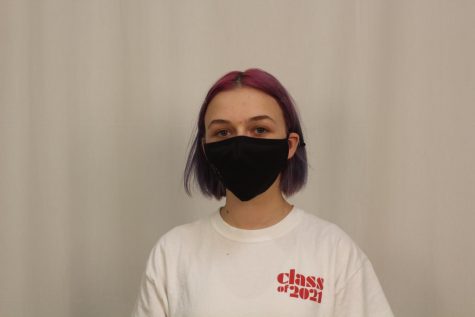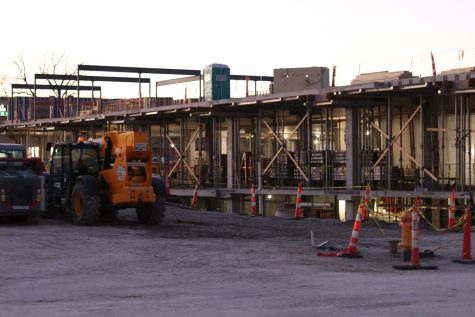In-Depth: The next step
Art by Graesen Joyce. In response to the vandalism on Jan. 6, 2021 involving racial slurs spray-painted onto three KSD schools, Black students have spoken out about their experiences with racism in Kirkwood. TKC interviewed Black students and teachers about their thoughts on the next steps they feel Kirkwood must take to address racial injustice, and how to stop it at its source.
In response to the vandalism on Jan. 6, 2021 involving racial slurs spray-painted onto three KSD schools, Black students have spoken out about their experiences with racism in Kirkwood. TKC interviewed Black students and teachers about their thoughts on the next steps they feel Kirkwood must take to address racial injustice, and how to stop it at its source.
Jordan Reid, junior, said he suspects that racism in Kirkwood is prevalent because many people are stuck in their own bubble. He said non-Black people do not understand other perspectives because of this.
“Kirkwood is a little more sheltered than other parts of Missouri and even other parts of St. Louis,” Reid said. “There’s not a lot of perspectives that the students at the high school and sometimes even the teachers and administrators [see]. There’s not [different] perspectives that they can switch to and see situations from [because they are sheltered].”
After the hate crime, many Black students expressed their fear and frustration with the situation over social media. Romona Miller, associate principal and Pioneer Pathways principal, said she saw this situation as a teachable moment, regardless of whether or not educators in KSD decided to take this opportunity to educate their students.
“It’s a time for teachers [and] administrators to take that opportunity to have us all look at the biases we have, to look at [our] actions, [discuss] this whole debate between [whether it should’ve] been classified as a hate crime or not,” Miller said. “To even hash that out would generate such a great conversation. The majority of the teachers don’t know that there are students in their buildings who [are affected by racism] daily.”
Miller said one way teachers can begin to understand racial inequality better is by attending the monthly Kirkwood equity speaker series which provides information on racial inequity issues so that racial injustices in the future can be responded to in a more productive way. More information can be found on the KSD website under the “equity” tab. She said this series is a great way for teachers to educate themselves on systemic racism, then transfer what they learn to their students.
“We’ve had a lot of community members and teachers participate [in the Kirkwood equity series],” Miller said. “The more education you can have around cultural responsibility, dealing with differences [and] dealing with biases, the more we deal with that as professionals, the easier it’s going to be to transfer that information and knowledge to [students].”
Lauren Hulsey, junior, said she sometimes feels uncomfortable when having to confront people who are racist to her. Miller said Black students must use their voices to address racism rather than accepting it.
“The Civil Rights movement was built on people that did [not] have voices, [who] decided that they were going to make a voice for themselves,” Miller said. “I would tell them definitely they have to stand up, they have to speak out. They shouldn’t just say ‘this is something that happens so I’m just going to think it’s acceptable.’ We need to bring things to the forefront, they need to be addressed [and] they need to be corrected. There is power in [using] their own voice.”
Reid said while it is important for Black students to use their voices, at this point the people they are addressing need to learn how to listen. He said correcting racism does not work unless the other side fully understands where they are at fault.
“It’s less about having to amplify Black voices, it’s [more] about the people around us having to listen more closely. It’s because they’re afraid of confronting conscious or unconscious racism that they carry [that they don’t want to listen],” Reid said. “When someone tells you that you’re racist, you don’t wanna take that to heart, you never want to believe that you’re racist. [And] that’s just listening to someone [with the intent] to respond instead of listening to someone and taking it to heart. The Black students have done enough at Kirkwood to just try and make our voices heard. It’s up to the people around us to start listening.”
Along with non-Black people not listening to their Black peers, Reid said the majority is currently only tolerating other cultures rather than accepting them. He said integrating more diverse cultures into the Kirkwood community could help remove the bubble surrounding the majority.
“We need to move past the idea of being tolerant of other races and move toward the idea of celebrating other races,” Reid said. “[We need to celebrate] the fact that we’re given the opportunity to surround ourselves with so many different kinds of people [and] so many different kinds of cultures. [We need to] reintroduce the importance of different ethnic cultures into the community because we need to let people know that other people exist.”
Hulsey said as a minority she feels she cannot express her opinions among her white classmates. KHS currently has 25 staff members who are Black, nine of which are teachers. Hulsey said having more diverse staff in KSD would both provide minority students outlets to express their opinions, and help white students see other perspectives.
“A lot of students still have the same mindset that I used to have [which was] ‘what’s the point of me talking to [white staff]. They don’t understand so what can they say to me to make me feel better,’” Hulsey said. “‘All they know is what they learn in school, they can’t really have a genuine conversation with me because they don’t understand.’”
Due to the lack of understanding white students and staff have of minority struggles, Hulsey said there needs to be more racial injustice education opportunities. During homeroom, students have to complete digital citizenship lessons on how to appropriately use technology and the internet. Hulsey said homeroom could be a good opportunity to educate people on racial inequality issues as well.
“We are learning about cyberbullying and [how to appropriately use the internet],” Hulsey said. “Why can’t why can’t one of those [lessons] throughout the school year be about hate crimes, racism and racial slurs? I feel like if you give a racist student an opportunity to learn about why their thoughts are wrong and why what they are doing or saying is wrong, they’re not going to take the opportunity. If you make them pay attention, it will help [educate] a lot more [students].”
Your donation will support the student journalists of Kirkwood High School. Your contribution will allow us to purchase equipment and cover our annual website hosting costs.

she/her
Hobbies and Interests: writing, baking, hanging out with friends, bullet journaling, watching movies
Favorite song: good 4 u by Olivia Rodrigo
Favorite...

she/her
Favorite musical artist: The 1975
Favorite quote: “Don't bother just to be better than your contemporaries or predecessors. Try to be better...

She/Her
Hobbies and Interests: photography, piano, hiking, reading
Favorite song: New Year's Day by Taylor Swift
Favorite Quote: "To define...

















